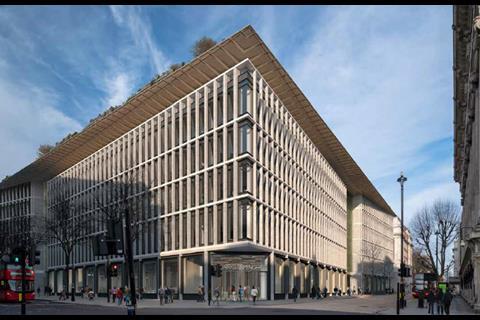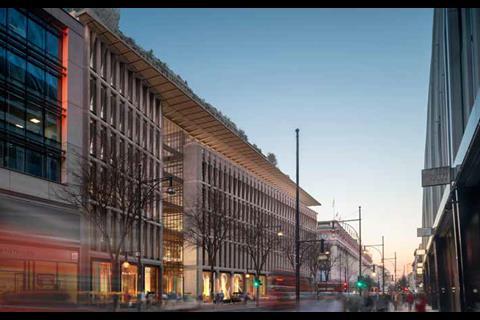Save Britain’s Heritage hails “hugely important decision” as Pilbrow & Partners plans are considered to emit too much carbon
Michael Gove has refused permission for Marks & Spencer to rebuild its flagship Oxford Street store in a landmark ruling which will send shockwaves through the built environment sector.
The communities secretary today announced he is ignoring the planning inspector’s recommendation to approve the Pilbrow & Partners-designed scheme following a high stakes public inquiry.
The plans would have seen the demolition of three buildings currently occupied by M&S, including the 1929 Art Deco Orchard House, and the construction of a 10-storey replacement store and office block.
The case has become a cause célèbre for net zero and heritage issues and Gove’s decision is expected to be highly influential for the future of major demolish and rebuild projects.
It hinged on whether a full rebuild or a refurbishment of the existing store would be more sustainable, with the retailer arguing the greater energy efficiency of the new building would offset the embodied carbon emitted by a rebuild.
In a 127-page report on the decision, the Department of Levelling Up, Housing and Communities (DLUHC) said Gove had concluded that the proposed redevelopment would emit “far more” carbon emissions than a refurbishment unless the UK’s grid was decarbonised.
The report said Gove believed that if the redevelopment was delayed until the grid had achieved net zero, the extent of embodied carbon emitted by manufacturing materials and from vehicle emissions would be “much lower or eliminated”.
“He agrees that the proposed development now would result in far more carbon emissions than after the UK has achieved a net-zero grid, because a fully renewably sourced electricity grid should allow most construction vehicles, and the manufacture of concrete, steel and other materials, to be undertaken using renewable energy rather than fossil fuels,” the report said.
M&S has argued the “failing” existing store suffered from an inefficient building envelope, and its proposed replacement would use the latest techniques for energy efficiency and could achieve a BREEAM Outstanding rating.
But DLUHC’s report said that while Gove had taken into account the retailer’s arguments that the building would emit less carbon over the course of its life than a refurbishment, there is uncertainty over the calculations.
“The understanding of [whole life carbon] assessments and the tools available for calculations are still developing, and therefore it is no surprise that there was disagreement over the lifetime carbon usage for the proposals and, more particularly, for a refurbishment,” it said.
On the scheme’s heritage impact, Gove is said to have concluded there would be no “direct effect” on heritage assets but that the plans would result in harm to the significance of nearby assets, including the neighbouring grade II*-listed 1909 Selfridges store.

Gove argues the height and appearance of the corner of the proposed scheme would be “prominent and distracting from the Selfridge’s façade”, especially when compared with the deferential appearance of the existing Orchard House.
This harm is believed to be “at the upper end” of the less than substantial category, and includes the impact of the proposals’ upper storeys on views from North Audley Street.
Gove is said to consider the harm to Selfridges to carry a “very great weight” and to disagree with the planning inspector’s assessment that this harm carries only “moderate” weight.
The secretary state added that the unlisted Orchard House “possesses architectural and historic interest” and “contributes positively to the settings of Sefridges and the historic retail character of Oxford Street”.
Gove is also said to have agreed with Historic England’s assessment of the proposals to be a “missed opportunity to retain, reuse and adapt the good quality elements of the site”.
The case against the proposals was led by Save Britain’s Heritage in the public inquiry which concluded in November last year.
The campaign group’s director Henrietta Billings described Gove’s move as a “hugely important decision that rightly challenges the way we continually and needlessly knock down and rebuild important buildings across our towns and cities.”
She added: “Repurposing and converting buildings we cherish and saving thousands of tonnes of C02 in the process is a no brainer. This is a massive positive step and we salute the Secretary of State.”
Simon Sturgis, the group’s expert witness at the inquiry and founder of carbon consultancy Targeting Zero, said: “Congratulations to Michael Gove for a very important and influential decision. This shows that the government is serious about the climate crisis and understands that real change is needed if we are to achieve net zero by 2050.
“We must now progress with nationwide guidance on planning and building regulations (eg Part Z) to support this decision and deliver carbon reductions across the entire built environment industry.”




















3 Readers' comments